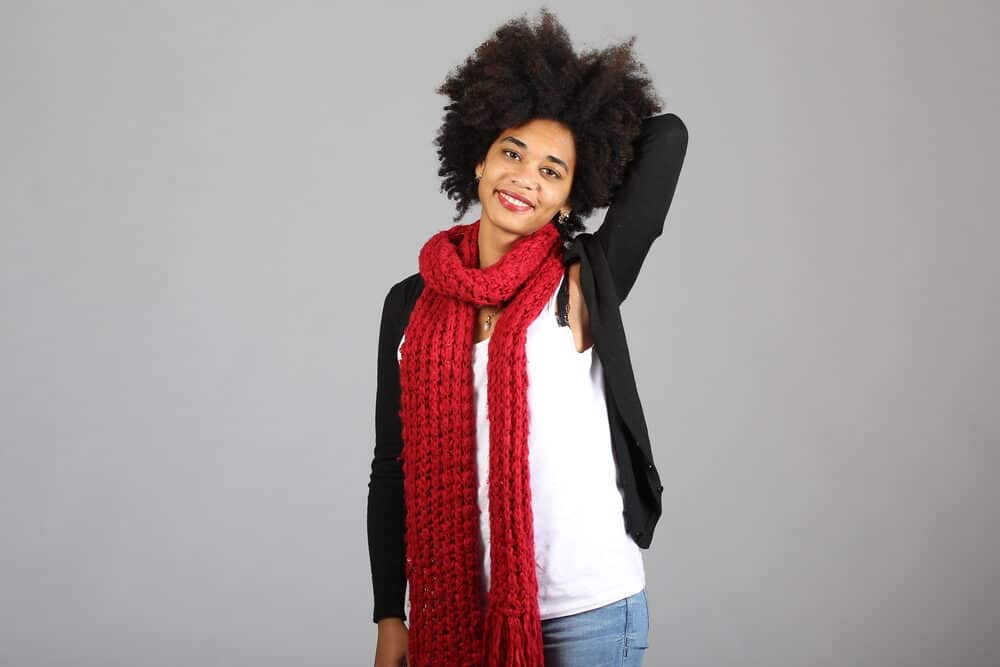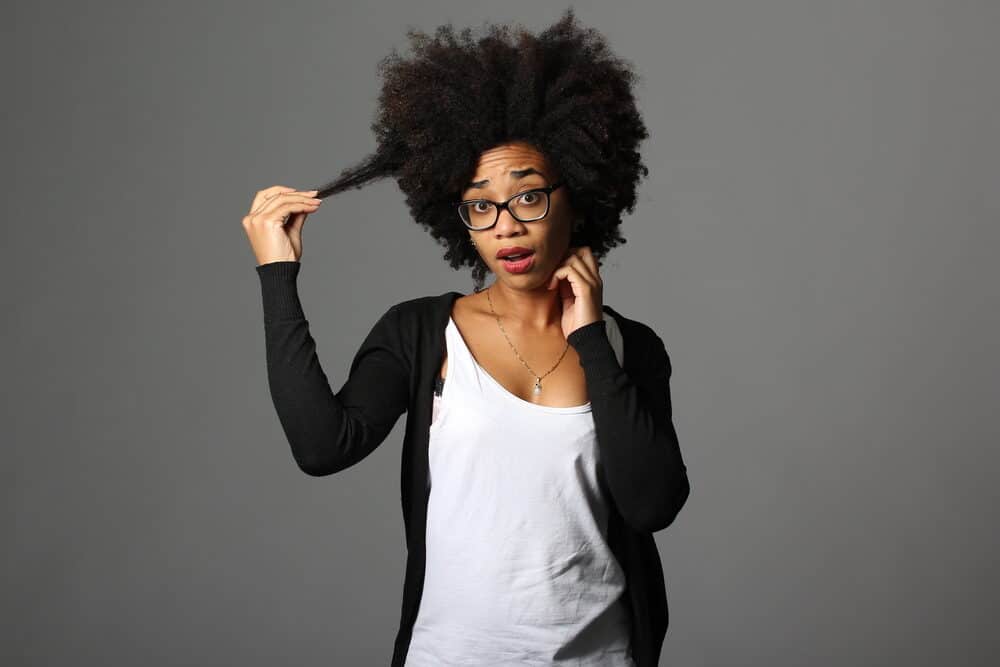
Starting your natural hair journey should be a celebration, but due to its steep learning curve, it often turns into a massive source of frustration.
It takes a lot of research and trial-and-error to find out your curl pattern, what it needs, and how to care for it.
Your journey may include trying out products, techniques, and more to figure out what works best for your coily hair strands. Since finding the right information about coily hair can be difficult, we’d like to offer some assistance.
In this article, we’ll dispel some rumors and deliver some reliable information so you can make the most of your gorgeous curls.
Table of Contents
- 1 What Is Coily Hair?
- 2 What Is the Difference Between Curly Hair and Coily Hair?
- 3 What Curly Hair Types are Considered Coily?
- 4 How to Care for Coily Hair
- 5 Other Coily Hair Care Tips
- 6 Trim Your Ends as Needed
- 7 Styling Tips
- 8 Use Protective Styling Regardless of Curl Pattern
- 9 Protect Your Hair at Night
- 10 Use Quality Hair Products
What Is Coily Hair?

Understanding your hair type enables you to handle it better, and the more care and love you give your hair, the healthier and stronger it will become. Let us introduce you to the specifics of the coily hair type to help you kickstart your research.
Coily hair is characterized as type 4 on the hair type spectrum. It can be soft and fine, harsh and wiry, or anything in between. These extremely tight curls take on somewhat of a zig-zag pattern.
Coily hair is known to be especially fragile because it doesn’t have very many cuticle layers to keep it from drying out. Also, due to the twists and turns characterizing coily hair, the natural oils from the scalp aren’t able to move down the strands efficiently.
That's why coily hair has significant issues with dryness, tangling, and shrinkage. But, with proper care, it can still look absolutely beautiful.

What Is the Difference Between Curly Hair and Coily Hair?
The shape of your scalp’s hair follicles determines your curl type. People with straight hair have circular hair follicles, while those with curly hair have oval-shaped hair follicles.
But how can you tell the difference between curly and coily hair if they are both considered textured hair?
“Curly” is often used as an umbrella term for all textured hair, but there are some specific differences between curly and coily hair that you should know about.
Coils are easy to distinguish from curls because they’re smaller, tighter, and springier. They also take on more of a Z-shape rather than an S-shape.
The final difference between coily and curly hair is that coily hair is usually much drier than curly hair due to the fact that their tiny twists and turns make it near impossible for scalp oils to lubricate the hair shaft.
What Curly Hair Types are Considered Coily?

In this section, we’ll fill you in on which curl types are considered coily. Knowing your exact coily hair type will give you more insight into how to care for it.
Type 4A

4A coils are tight with a wiry or fine texture and a noticeable S pattern. 4A hair strands are often referred to as s-shape coils with the circumference of a crochet needle.
Type 4B

If your hair has densely packed curls in a sharp letter Z pattern without much definition, then your hair is type 4B. This type has tighter coils but can be thin or coarse.
Type 4C

Similar to type 4B hair, 4C coils are incredibly tight with a harder-to-spot zigzag shape. 4C coils have even less definition and a ton of shrinkage. You can expect up to 75% shrinkage with this hair type.
Type 4 hair is the most fragile hair type, so it needs a lot of protection to remain healthy. In this next section, we’ll tell you all you need to know about caring for your coily hair.
Note: Read this article to learn more about the various hair typing systems, including type 1, type 2, type 3, and type 4. This has always been a popular topic for women within the natural hair community.

How to Care for Coily Hair
Coily hair has a striking look that is near-impossible to imitate. It’s got incredible volume and lends itself well to a wide variety of hairstyles. But it also comes with a few critical issues that can be challenging for naturals to overcome.
Coils are more prone to dryness and breakage, making them more delicate than other hair types. Because of this, they require much more care and attention than other hair types.
But there’s no need to worry - we’ll give you a rundown of all things coily hair care!
Keep It Moisturized
As established before, coily hair has kinks where the strands twist and turn. At every single stress point in each spiral, curl, or coil, the chances of moisture reaching and staying in the hair are greatly reduced.
This is why coily hair is so dry. As a result, your first priority should always be hydration.
Get Rid of Harsh Shampoo
We’ll bet you’ve heard the spooky tales of regular shampoo and what it does to coily hair. The tales are true - regular shampoo can wreak havoc on your strands, leaving them dry and prone to breakage.
Instead of drying your hair out with detergent-like shampoo, go sulfate-free! Sulfate-free shampoo is a curlyhead's best friend. It removes extra sebum and product build-up without stripping your hair of any necessary moisture.

Use the LOC Method
The LOC method reigns supreme as the best way to lock in lasting moisture for coily heads.
The acronym LOC stands for the sequence in which you have to apply your hair care products: Liquid, Oil, Cream. While the LOC method is the most common type 4 hair moisturizing method out there, other variations on this method exist, like:
- LCO method: Apply liquid, cream, and then oil.
- LOCS method: Apply liquid, oil, cream, and then a heavy oil-based sealant.
- LOG method: Apply liquid, oil, and then gel.
*Keep in mind that the liquid part of these techniques can be water or a water-based leave-in conditioner. These techniques are to be used after you wash and condition your hair.
Each method will produce different results on different hair, so you’ll need to try multiple moisturization methods to see which one will work best for your hair.
Wet Your Hair Regularly
Coily hair needs moisture above all else, and water is the most effective source of hydration. So, make sure you wet your hair at least once a week. You can wet your hair more often if you’d like. The drier your hair is, the more often you should wet it down.
Condition/Deep Condition Every Wash Day
Washing your hair even with a sulfate-free shampoo has the potential to dry out your strands. So, after washing your hair, it’s imperative to replenish that moisture with a rinse-out conditioner.
If you have chronically dry hair, consider using a deep conditioning treatment on your hair for added moisture and hydration.
You can deep condition it once a week or space it out depending on your hair needs. Generously apply a hair mask with rich components like cocoa butter, aloe vera, honey, black seed oil, or olive oil and leave it on for 15 minutes or up to an hour.
For the best results, cover your hair with a plastic cap or use a blow dryer (on a low heat setting) to maximize the effects of the treatment by opening up your hair cuticles.
You might need to try out different products to find the one that works best for you in this treatment, and that’s totally normal!

Other Coily Hair Care Tips
Now that you know how to keep your hair moisturized let’s jump into some other tips that you can use to keep your coils bouncy and beautiful.
Trim Your Ends as Needed
It is vital to trim coily hair on an as-needed basis. Getting trims every now and then can help mitigate tangles and knots, especially at the ends where split-ends usually form. Doing so will also help your hair stay refreshed and healthy.
Keep in mind that trimming your hair makes it shorter and doesn't make it grow. So, trimming too often or on a defined schedule isn't recommended.
There are a lot of stylists that specialize in trimming curly hair - they can assist you with this. They know that avoiding blunt lines works best for coily hair. They also know that curls are better to cut dry since they stretch when wet or damp.
But you don’t have to go to a professional to get your hair cut. There are tons of tutorials online that can help you get it right.
Styling Tips
Styling your coily hair can look so effortless, but it can be incredibly difficult. The trick is to be patient with your hair and be mindful of how much damage you inflict on your strands.
We have a few tips that we think you will really love for your coily hair. For instance, for bouncier and springier hair, be sure to apply products lightly, especially at the crown of your hair.
Another helpful tip is to stretch out your hair when it’s damp and dry it with a diffuser for longer and looser curls. Here are some more tips you can use to make the styling process easier.
Get Used to Frizz
Frizz is such a natural part of the texture of kinky hair. Embracing it is always better than fighting it.
In fact, fighting against it constantly may cause you to inflict hair damage, which we definitely don’t want. But you’ll find some anti-frizz tips ahead, so just keep reading!
Finger Detangle
We advised you to never comb your hair while it’s dry since it causes so much breakage. To avoid this dreadful fate, opt for detangling your hair when it is coated in conditioner, whether it’s wet or damp.
Using your fingers to detangle works like magic and reduces your chances of ripping through your strands, so try that out before resorting to a comb.
If you do end up needing it, combing with a wide-tooth comb from the bottom up will ensure less breakage. A hairbrush is a no-go, though!
Air Dry to Minimize Damage
Always, always, always air dry your coily hair to decrease frizz as much as possible.
Avoid heat exposure when you can, even though using a diffuser -on cool- will probably speed up your dry time and minimize frizz. Styling your hair while it is damp instead of drenched and applying product wisely will also speed up your drying time.
Style Infrequently
Styling your coily hair often will often lead to breakage since it is so fragile. So, we recommend that you style your hair infrequently - weekly to bi-weekly styling sessions are standard.
If you wear your hair in protective styles often, you won’t have any issues with over-styling your hair. But if you wear short-term styles, you may be tempted to redo your hair more often.
Try not to style your hair every day, as this will increase the risk of mechanical damage from over-manipulation.
Low-maintenance hairstyles, like box braids, lemonade braids, and mini twists, are our favorite!
Take Your Time and Section
Sectioning your hair throughout each step of the washing, conditioning, and styling process will make your hair easier to manage.
While it does take a bit of extra time to section your hair, you’ll realize immediately that it makes the whole wash-day process much easier.

Use Protective Styling Regardless of Curl Pattern
Coily hair needs a lot of care but not necessarily a lot of styling. You can always rock your coils au naturel. But if you do want to switch it up and try a protective style, here are some things to keep in mind.
- Make sure the style isn’t too tight - It’s become commonplace to see people wear extremely tight protective styles. And, while tighter hairstyles often look neater than looser styles, you should always make sure that your stylist doesn’t do your hair too tight.
- Don’t leave your protective style in too long - Every protective style has an expiration date - it’s usually from a week to 2 months. If you leave your protective style in for too long, you run the risk of getting stubborn buildup and experiencing breakage at your roots.
- Give your hair a break in between styles - After taking out a protective style, it’s always a great idea to give your hair a break. Let your hair rest for at least a week in between protective styles to reduce ongoing hair manipulation.
Protect Your Hair at Night
Caring for your coily hair doesn’t stop when you turn in for the night - it’s important to protect your coils even when you sleep. Here are a couple of ways to ensure that your hair stays protected while you are asleep:
- A silk pillow or pillowcase is great for frizz prevention since it limits a lot of the friction between your hair and the pillowcase fabric.
- You could also wrap your hair in a silk scarf or bonnet to preserve your hair’s moisture overnight.

Use Quality Hair Products
When it comes to hair products, you have a lot of options, but not all of them will be good for your hair.
Many products marketed toward those with curly hair may state “for natural hair” or “for coils,” but they may not have the right ingredients in them to support the health of your hair.
The best way to judge whether a particular hair care product is good for your hair is to check the ingredient list. In this section, we’ll fill you in on the good ingredients and the bad ingredients you’ll find in curly hair products.
Let’s get right into it!
Product Ingredients to Avoid
- Sulfates are harsh detergents that strip your hair of all moisture. They are usually found in shampoos and should be avoided in virtually all cases.
- Silicones, which often end in 'cone, 'xane, 'onol, can be bad for your hair. The problem with silicones is that some of them are not water-soluble, meaning that they can be hard to wash out of your hair. If your product has one of such silicones in it, it could cause buildup over time and suffocate your strands. This ultimately leads to dryness and even breakage. Here’s a resource you can use to find out which silicones are okay and which are not.
- Mineral oils can be detrimental to textured hair. Not only do these oils coat the hair so that moisture cannot enter, but they also clog your scalp and inhibit hair growth.
- Waxes should be avoided for the same reason that mineral oils should. They coat your hair and keep moisture from penetrating.
- Some alcohols, like isopropyl alcohol and denatured alcohol dry out your hair. They should be avoided to maintain your hair’s moisture levels.
Also, based on your personal preferences, you may also want to avoid any products with parabens, fragrances, or phthalates.

Good Product Ingredients for Your Hair Care Routine
- Hydrating oils like argan oil and jojoba oil moisturize your hair from within, promoting length retention and overall hair health.
- Sealants, like shea butter, castor oil, and certain gels, help to seal in the moisture from other hydrating products you apply to your hair.
- Glycerin is a humectant that draws moisture into your hair from the air.
- 4D Natural Hair
- What Is Natural Hair?
- Can White People Have 4C Hair?
- How to Change Your Hair Texture From 4C to 3C
By this point, you may feel like your coily hair is going to be a lot of work, and this may be the case in the beginning. But, over time, as you learn what your hair likes and dislikes, caring for your hair will get much, much easier.
With proper hydration, styling, and maintenance, your hair will grow and flourish into the mane of your dreams!




